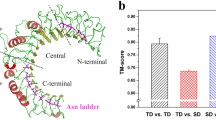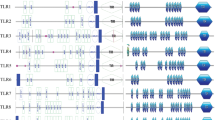Abstract
The Toll-like receptor (TLR) gene family consists of type 1 transmembrane receptors, which play essential roles in both innate immunity and adaptive immune response by ligand recognition and signal transduction. Using all available vertebrate TLR protein sequences, we inferred the phylogenetic tree and then characterized critical amino acid residues for functional divergence by detecting altered functional constraints after gene duplications. We found that the extracellular domain of TLR genes showed higher functional divergence than that of the cytoplasmic domain, particularly in the region between leucine-rich repeat (LRR) 10 and LRR 15 of TLR 4. Our finding supports the concept that sequence evolution in the extracellular domain may be responsible for the broad diversity of TLR ligand-binding affinity, providing a testable hypothesis for potential targets that could be verified by further experimentation.


Similar content being viewed by others
References
Akira S, Takeda K, Kaisho T (2001) Toll-like receptors: critical proteins linking innate and acquired immunity. Nat Immunol 2:675–680
Anderson K, Nusslein-Volhard C (1986) Dorsal-group genes of Drosophila. In: Gall J, ed. Gametogenesis and the early embryo. New York: Alan R. Liss, 177–194
Casari G, Sander C, Valencia A (1995) A method to predict functional residues in proteins. Nat Struct Biol 2:171–178
Gaucher EA, Gu X, Miyamoto MM, Benner SA (2002) Predicting functional divergence in protein evolution by site-specific rate shifts. Trends Biochem Sci 27:315–321
Gaucher EA, Miyamoto MM, Benner SA (2001) Function-structure analysis of proteins using covarion-based evolutionary approaches: Elongation factors. Proc Natl Acad Sci USA 98:548–552
Gu J, Wang Y, Gu X (2002) Evolutionary analysis for functional divergence of Jak protein kinase domains and tissue-specific genes. J Mol Evol 54:725–733
Gu X (1999) Statistical methods for testing functional divergence after gene duplication. Mol Biol Evol 16:1664–1674
Gu X (2001) Maximum likelihood approach for gene family evolution under functional divergence. Mol Biol Evol 18:453–464
Gu X, Vander Velden K (2002) DIVERGE: Phylogeny-based Analysis for Functional-Structural Divergence of a Protein Family. Bioinformatics 18:500–501
Gu X (2004) Statistical framework for phylogenetic analysis of expression profiles. Genetics 167:531–542
Gu X, Zhang Z, Huang W (2005) Rapid Evolution of Expression and Regulatory Divergences after Yeast Gene Duplications. PNAS 102:707–712
Hajjar AM, O’Mahony DS, Ozinsky A, Underhill DM, Aderem A, Klebanoff SJ, Wilson CB (2001) Cutting edge: functional interactions between toll-like receptor (TLR) 2 and TLR1 or TLR6 in response to phenol-soluble modulin. J Immunol 166:15–19
Lemaitre B, Nicolas E, Michaut L, Reichhart JM, Hoffmann JA (1996) The dorsoventral regulatory gene cassette spatzle/Toll/cactus controls the potent antifungal response in Drosophila adults. Cell 86:973–983
Livingstone CD, Barton GJ (1996) Identification of functional residues and secondary structure from protein multiple sequence alignment. Methods Enzymol 266:497–512
Means TK, Golenbock DT, Fenton MJ (2000) Structure and function of Toll-like receptor proteins. Life Sci 68:241–258
Medzhitov R, Preston-Hurlburt P, Janeway CA Jr (1997) A human homologue of the Drosophila Toll protein signals activation of adaptive immunity. Nature 388:394–397
Nomura N, Nagase T, Miyajima N, Sazuka T, Tanaka A, Sato S, Seki N, Kawarabayasi Y, Ishikawa K, Tabata S (1994) Prediction of the coding sequences of unidentified human genes. II. The coding sequences of 40 new genes (KIAA0041-KIAA0080) deduced by analysis of cDNA clones from human cell line KG-1 (supplement). DNA Res 1:251–262
Pollock DD, Taylor WR, Goldman N (1999) Coevolving protein residues: maximum likelihood identification and relationship to structure. J Mol Biol 287:187–198
Saitou N, Nei M (1987) The neighor-joining method: a new method for reconstructing phylogenetic trees. Mol Biol Evol 4:406–425
Schupbach T, Wieschaus E (1989) Female sterile mutations on the second chromosome of Drosophila melanogaster. I. Maternal effect mutations. Genetics 121:101–117
Smirnova I, Poltorak A, Chan EK, McBride C, Beutler B (2000) Phylogenetic variation and polymorphism at the toll-like receptor 4 locus (TLR4). Genome Biol http://www.genomebiology.com/2000/1/1/research/002.1.
Takeuchi O, Akira S (2001) Toll-like receptors; their physiological role and signal transduction system. Int Immunopharmacol 1:625–635
Tauszig S, Jouanguy E, Hoffmann JA, Imler JL (2000) Toll-related receptors and the control of antimicrobial peptide expression in Drosophila. Proc Natl Acad Sci USA 97:10520–10525
Thompson JD, Gibson TJ, Plewniak F, Jeanmougin F, Higgins DJ (1997) The CLUSTAL_X windows interface: flexible strategies for multiple sequence alignment aided by quality analysis tools. Nucleic Acids Res 25:4876–2882
Werling D, Jungi TW (2003) TOLL-like receptors linking innate and adaptive immune response. Vet Immunol Immunopathol 91:1–12
Zarember KA, Godowski PJ (2002) Tissue expression of human Toll-like receptors and differential regulation of Toll-like receptor mRNAs in leukocytes in response to microbes, their products, and cytokines. J Immunol 168(2):554–61
Author information
Authors and Affiliations
Corresponding author
Rights and permissions
About this article
Cite this article
Zhou, H., Gu, J., Lamont, S.J. et al. Evolutionary Analysis for Functional Divergence of the Toll-Like Receptor Gene Family and Altered Functional Constraints. J Mol Evol 65, 119–123 (2007). https://doi.org/10.1007/s00239-005-0008-4
Published:
Issue Date:
DOI: https://doi.org/10.1007/s00239-005-0008-4




